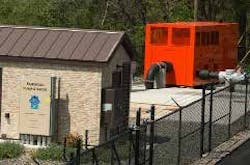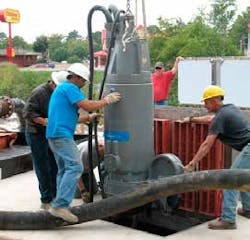The City of Hot Springs wastewater treatment system serves 23,000 customers and requires maintenance of more than 600 miles of gravity and force mains. With an eye toward implementing a more proactive maintenance program and addressing issues arising from capacity constraints and aging equipment, the city undertook a comprehensive overhaul of its municipal wastewater infrastructure, including a complete revamp of its Fairwood Lift Station.
Scope
The 5.8 million gallon per day (mgd) Fairwood Lift Station, one of 76 major stations in the Hot Springs system, experienced frequent overflows. Particularly, the station struggled during heavy rainfall events or when pumps clogged because of increasingly popular “disposable” products such as duster heads, cleaning cloths, and disinfecting wipes, which can build up on the leading edge of the pump impeller and become entangled, reducing the efficiency of the pump or even causing a complete stoppage.
The award-winning N-pump technology incorporates patented clog-resistant impellers designed to handle debris-laden wastewater more efficiently than even traditional chopper style pumps through the combination of a self-cleaning impeller and a relief groove incorporated in the pump volute.
Solution
The Hot Springs utility has had extended success with high-performance Flygt N-pumps installed elsewhere in the treatment system, and the new Fairwood station will be equipped with Xylem Flygt Model NP-3231/765N-pumps. The 335-HP submersible pumps will be operated via variable speed drive and are designed to deliver 4,050 GPM each.
Horizontally positioned impeller vanes deliver superior hydraulic performance and energy efficiency by self-cleaning the stringy material carried in the wastewater flow away from the leading edge of the pump impeller.
A new Xylem Flygt MultiSmart station controller will provide both real-time control and protection along with historical and communications options. The installed MAS 711 pump monitoring system, which records pump starts and stops; pump vibration; station power quality and energy usage; and pump bearing and seal temperatures, will calculate and record the daily inflow and outflow of the station in gallons per day. All of this information will be available to the city for monitoring and review, allowing them to better operate the pumps and more easily determine the root cause of any future problems.
“The availability of a natural gas connection on-site will eliminate the risks of aging diesel fuel gelling in the generator fuel tank and the potential for fuel spills that could reach the nearby creek, while reducing the city’s fuel costs during an outage of the submersibles,” Harris explained.
The potential environmental impact of sanitary sewer overflows (SSOs) at the Fairwood facility mandated a backup system that would continue operation during a power outage. Utility field operations manager Bobby Harris, together with design engineer Jerry Williams, PE, the principal of local engineering consultant Engineers, Inc., chose the Xylem Godwin Dri-Prime Backup pump unit as a backup for the Fairwood Station.
Powered by a 425-HP natural gas engine, the HL250M DBS pump will operate on an above-ground foundation adjacent to the wet well. The heavy-duty pump was well suited for the backup mission because of its self-priming feature and ability to handle the high discharge pressure and high suction lift conditions at the new Fairwood station, which underwent some dimensional redesign to accommodate increased flow requirements.
Editor's Note: Scranton Gillette Communications and the SGC Water Group are not liable for the accuracy, efficacy and validity of the claims made in this piece. The views expressed in this content do not reflect the position of the editorial teams of Water & Wastes Digest, Water Quality Products and Storm Water Solutions.

